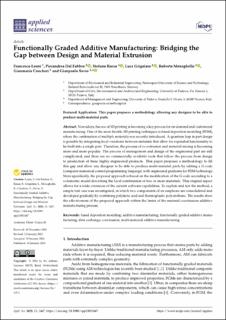| dc.contributor.author | Leoni, Francesco | |
| dc.contributor.author | Dal Fabbro, Pierandrea | |
| dc.contributor.author | Rosso, Stefano | |
| dc.contributor.author | Grigolato, Luca | |
| dc.contributor.author | Meneghello, Roberto | |
| dc.contributor.author | Concheri, Gianmaria | |
| dc.contributor.author | Savio, Gianpaolo | |
| dc.date.accessioned | 2023-10-26T13:23:31Z | |
| dc.date.available | 2023-10-26T13:23:31Z | |
| dc.date.created | 2023-03-08T14:20:54Z | |
| dc.date.issued | 2023 | |
| dc.identifier.citation | Applied Sciences. 2023, 13 (3), . | en_US |
| dc.identifier.issn | 2076-3417 | |
| dc.identifier.uri | https://hdl.handle.net/11250/3098989 | |
| dc.description.abstract | Nowadays, the use of 3D printing is becoming a key process for on-demand and customized manufacturing. One of the most flexible 3D printing techniques is fused deposition modeling (FDM), where the combination of multiple materials was recently introduced. A quantum leap in part design is possible by integrating local variations between materials that allow for expanded functionality to be built into a single part. Therefore, the process of co-extrusion and material mixing is becoming more and more popular. The process of management and design of the engineered part are still complicated, and there are no commercially available tools that follow the process from design to production of these highly engineered products. This paper proposes a methodology to fill this gap and allow any designer to be able to produce multi-material parts by editing a G-code (computer numerical control programming language) with engineered gradients for FDM technology. More specifically, the proposed approach is based on the modification of the G-code according to a volumetric model describing the local combination of two or more materials. This original aspect allows for a wide extension of the current software capabilities. To explain and test the method, a simple test case was investigated, in which two components of an earphone are consolidated and developed gradually by combining polylactic acid and thermoplastic polyurethane. The results show the effectiveness of the proposed approach within the limits of the material coextrusion additive manufacturing process. | en_US |
| dc.language.iso | eng | en_US |
| dc.publisher | MDPI | en_US |
| dc.rights | Navngivelse 4.0 Internasjonal | * |
| dc.rights.uri | http://creativecommons.org/licenses/by/4.0/deed.no | * |
| dc.title | Functionally Graded Additive Manufacturing: Bridging the Gap between Design and Material Extrusion | en_US |
| dc.title.alternative | Functionally Graded Additive Manufacturing: Bridging the Gap between Design and Material Extrusion | en_US |
| dc.type | Peer reviewed | en_US |
| dc.type | Journal article | en_US |
| dc.description.version | publishedVersion | en_US |
| dc.source.pagenumber | 0 | en_US |
| dc.source.volume | 13 | en_US |
| dc.source.journal | Applied Sciences | en_US |
| dc.source.issue | 3 | en_US |
| dc.identifier.doi | 10.3390/app13031467 | |
| dc.identifier.cristin | 2132421 | |
| cristin.ispublished | true | |
| cristin.fulltext | original | |
| cristin.qualitycode | 1 | |

